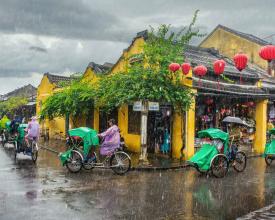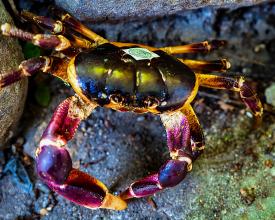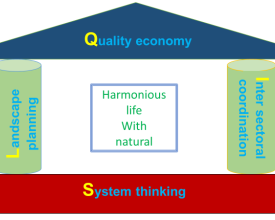
Applying the SLIQ approach for the integrated management of Nature and Culture in Cù Lao Chàm-Hôi An Biosphere Reserve, Vietnam

Cù Lao Chàm-Hôi An (CBR) was designated as a UNESCO Biosphere Reserve in 2009, with the Marine Protected Area of Cù Lao Chàm archipelago as the core zone and Hôi An Ancient Town, inscribed as World Heritage under criteria (ii) and (v) in 1999, as the transition zone. Riverside, natural wetlands, mangrove forest in estuary and the beaches of Hôi An city form the buffer zone connecting both areas. The archipelago is valued for its marine species with the islands containing mountainous areas and rainforest ecosystems. Hôi An, an ancient trading port, bears witness to the fusion of Vietnamese and European cultures. In order to develop an integrated management, MAB (Man and the Biosphere) Vietnam has designed the “Systemic thinking - Land/seascape planning - Intersectoral coordination with Involvement of Stakeholders - Quality economy Model” (SLIQ model) allowing policy makers, managers, local people and researchers to collaborate and address complex problems in a systemic way.
Context
Challenges addressed
The Biosphere Reserve includes protected areas as well as urban areas, which are interdependent. To align the objectives for the protection of cultural and natural heritage, considering sustainable development and benefits for the local population is the main challenge. The marine ecosystem of the Cù Lao Cham archipelago is very sensitive to climate change. Sediments and pollution from the mainland following the Thu Bon river basin are attacking coral reefs and sea-grass beds in the vicinity of the islands. Islands and estuary are facing hazards impacts from socio-economic activities along river basins and beaches along the coast. Typhoons and related flooding are directly impacting Hôi An ancient town. Fishing boats, tourist speed boats and ship movement jeopardize marine habitats and aquatic ecosystems in the Marine Protected Area. Infrastructure developments along the rivers, on sand dunes and on the beaches is modifying the morphology having impacts on habitats and lifecycles.
Location
Process
Summary of the process
To address the interdependency of natural and cultural systems is a requirement for designing and managing a biosphere reserve (BB2). In the case of CBR, the World Heritage and Intangible Cultural Heritage designations enabled a strong partnership between national and local cultural heritage and nature conservation agencies. By using the multi-designation scheme, the CBR management board coordinates with different levels and different legal instruments to conserve the CBR as a whole (BB1). The SLIQ model is applied in the design and management of the CBR considering zoning (BB3), the governance system and intersectoral management (BB4), and including concerns towards the benefits that local communities need to receive from these international designations, generating sustainable livelihoods (BB5).
Building Blocks
Coordinating body for multiple international and national designations
The CBR Management Board coordinates all activities that are related to the cultural and natural values of the Biosphere Reserve. In the development procedure, the CBR tries to create a safe place for stakeholders to work together and find out integrated solutions. One of the main tasks of the CBR Management Board is to coordinate the different international and national designations which include the Biosphere Reserve, the World Heritage site, the intangible cultural heritage, and the marine protected area. The master plan and implementation program of the CBR is always in the making, being updated and coordinated with stakeholders including the four main entities: government, scientists, private sector and local people. The majority of the leaders in the city were invited to be members of the management board of the CBR. This is an important characteristic of the system that serves to facilitate the collection of information and data, to discuss and to reflect at workshops and meetings, to analyze problems, and to find out solutions thereon. All of the CBR coordinators are responding to the balance between conservation and development, focusing on sustainable development and resilience to climate change.
Enabling factors
- The CBR has created a good relationship with local communities and stakeholders working together on conservation, livelihood development, eco-tourism and education becoming a space for system thinking, reflections on linkages with nature, and harmonization between humans and the biosphere.
- The existence of multiple designations such as the World Heritage designation, the Marine Protected Area (MPA) designation, and the Intangible Cultural Heritage designation call the attention of locals, authorities and tourists.
Lesson learned
With so many different designations at different levels, there are several approaches that are required to be integrated and coordinated in the action plans such as the ecosystem approach, watershed approach, integrated coastal management and the ridge to reef (2R) approach in order to develop management models. For example, the Quang Nam province has assigned 19 of 235 hectares of Cù Lao Chàm MPA area for the local fishermen in Bai Huong village to manage the marine resources and develop eco-tourism based on the conservation results since 2013. This is a shared decision-making process that includes the government, the local communities and other stakeholders. The local fishermen created the resources management plans by themselves. Using this system thinking, the local partners will be real owners of the natural and cultural resources. They are decision-makers in the maintenance of the values of the Biosphere Reserve for the future generations.
Understanding different scales of interactions between natural and cultural systems using the System thinking approach
System thinking is a scientific approach that starts with the whole. It is used for the design of individual biosphere reserves but also for connecting it to the whole international network. It takes into account complex relationships as well as “soft” variables that underpin human emotions, motivation and behavior thus providing a holistic approach to complex policy and social issues. From this perspective, biosphere reserves consist of various components which reflect complex relationships between natural and socio-economic factors, between physical structures and human values, between cultural space and natural landscape, political ecology and creative ecology. The application of system thinking is carried out from the preparation stage of nomination of a biosphere reserve to design, management planning and implementation. Applying system thinking to the design of a biosphere reserve allows to identify all elements of the larger ecosystem. In the case of CBR, this approach enables the connection between the ancient town, influential to the development of the whole ecosystem as a historic port and its cultural heritage in relation to the marine protected area.
Enabling factors
In CBR, the ecological interconnection between the heritage city and the protected area were clear and the design had to consider the interface of the estuary between the cultural systems (settlements) along Thu Bon River, the mangroves and the sea.
Lesson learned
(1) System thinking is a tool for managers and policy makers to outline appropriate solutions to practical problems.
(2) System thinking differentiates fundamental problems from their symptoms and facilitates both short-term interventions and long-term sustainable strategies.
Zoning based on patch-corridor-matrix model (Landscape Planning)
In order to set-up a functional zoning, the connection between the different components of land-use is vital. Landscape planning is a tool for integration and creates a feasible condition for implementing management based on system thinking. The use of the patch-corridor-matrix model from landscape ecology enables habitat connectivity and biodiversity conservation.
The CBR's zoning clearly identifies that the core zone is the MPA, which is responsible for protecting primary forests on the islands and the seascape. The transition zone is the ancient town, and these two conservation centers are connecting through the buffer zone of rivers, mangrove, estuary and sea. Each zone will have its own development plan based on the main CBR zoning. Specifically, in the core zone, the government does not allow the construction of large hotels, giving priority to develop homestays; the constructions are restricted in height, materials and operating procedures to ensure that do not disrupt forest and marine ecological landscape. In the transition zone, the old town is preserved through construction regulations. All socio-economic activities taking place in the buffer zone are planned based on the protection and promotion of the values of river, mangrove and beach ecosystems.
Enabling factors
One year after receiving the CBR designation by UNESCO, Hoi An city quickly established five economic development sub-zones (2010) and then adjusted them into three sub-zones corresponding to the three functional zoning of CBR. This confirms the city's development strategy based on the outstanding value of each area that CBR has assigned in the zoning and the linkages between natural and cultural resources in the whole CBR.
Lesson learned
(1) Need of principles for applying landscape ecology models that could be predictive.
(2) After many recommendations, the city has accepted to invite the CBR management board members to participate in most council approvals for planning ideas, infrastructure construction, projects investment, and all of services throughout the whole city. The SLIQ principle basing on the landscape, seascape and outstanding values of each zone in CBR has been used by CBR members to reflect and to comment on all projects’ proposals. This CBR consultation has been supporting the city in achieving its sustainable development goals while meeting the 7 criteria for CBR of UNESCO.
(3) The SLIQ model is also used to build sustainable livelihood models based on the value chain of natural resources and the benefit-sharing for many stakeholders involved.
(4) Moreover, CBR members are also invited to participate in the Strategic and Environmental Assessment (SEA) and Environment Impact Assessment (EIA) councils of most investment projects.
Partnering between state, market and civil society (Intersectoral coordination)
CBR management consists of the coordination and use of locally available instruments, human resources and financial resources. It requires to consider shared benefits and responsibilities in natural resource management of agriculture, forestry, fishery, science, involving local and national authorities and the international community. The intersectoral coordination consists of bringing actors from the state and civil society together to achieve a mutual understanding on an issue and negotiate and implement mutually agreeable plans for tackling the issue once it is identified. For this, top-down and bottom-up approaches can be combined. The management board is composed by provincial departments of agriculture and rural development, natural resources and environment, culture and tourism, and science and technology. These departments are under guidelines from Central Government, especially regulations applied for core zones, i.e. top-down approach. Besides, there are associations including farmers, women, youth, business enterprises, private sector participating in the management board and decision-making process, i.e. bottom-up approach. The leader is the provincial authority chaired by the vice-chairman of the People's Committee.
Enabling factors
International designation as a Biosphere Reserve.
Lesson learned
In tackling development problems, intersectional coordination is a strategy that optimizes the respective strengths of different sectors while limiting the impact of their individual weaknesses.
Using Biosphere Reserve Branding (Quality Economy)
Quality economy is based on successful conservation or conservation-based economy set up in the guidelines of Vietnam MAB in 2009. Labeling and branding goods and services from CBR could help promote the development of quality economies in the CBR and its sustainable development. In the context of economic development in CBR, quality includes value creation and increased economic benefits for local people consumptions; production in line with sustainable development; fair distribution, solidarity; awareness of conservation of nature and culture and networking among Bisophere Reserves. Successful conservation creates a prestige value. Labeling under this concept brings added value to local products creating a contribution and recognition to local communities and their efforts in conservation.
Enabling factors
International designation as a Biosphere Reserve.
Lesson learned
(1) Market sector consists of private entities that are organized around price incentive in the production and consumption of goods and services. The quality of products should be controlled and registered.
(2) Local products usually do not meet quality criteria, therefore, intersectoral coordination and quality economy should come together to implement the initiative with community participation involved in the process.
Impacts
Addressing the systemic values of the CBR is challenging, because even if CBR owns very rich natural and cultural resources, their linkages are almost invisible to common eyes. Using the SLIQ approach not only shows the values of nature and human cultures but also clarifies their outstanding interlinkages. Some impacts of the application of the SLIQ model in CBR are:
- Increased awareness of stakeholders (including government, scientists, the private sector and local communities) and change on their behavior, now focusing on protecting the linkages between natural and cultural resources.
- SLIQ supports the effective coordination of CBR activities, balancing between development and conservation.
- Use of SLIQ approach to lead all investments in CBR towards a sustainable development.
- Projects based on SLIQ model application such as the "Establishment the Fishery Refugia pilot model in two different habitats (coral reef and mangrove forest) in Cù Lao Chàm-Hôi An Biosphere Reserve" and the “Community-based conservation and sustainable harvesting of land crab of Cù Lao Chàm, Quang Nam”
Beneficiaries
All stakeholders, governing bodies, and local communities
Sustainable Development Goals
Story

Land crabs, Gecarcoidea lalandii, native to forest and tidal areas, are considered a tropic factor sustaining the food chain and food web in the marine-mountain ecosystem in the Cham Islands, core zone of the CBR. Land crab population is used as indicator of forest and marine ecosystems health and linkages.
Since 2009, the number of tourists increased quickly thereby increasing the land crab demand. Land crab has been under great pressure on population decline, the size of crab caught getting smaller. The city of Hoi An quickly issued a ban on exploitation and consumption activities of land crabs on Cham Islands from 2009. Since then, I think about applying the SLIQ model in all decision-making. It helped me understand that CBR's resources must be preserved, but they must also be properly exploited for local livelihoods.
From that thought, a set of criteria for land crab exploitation has been applied including: Catch, sale, and use time restrictions; land crab catch quota; land crab catch size restrictions; ban to catch female crabs carrying eggs; fixed price; and eco-labeling. The results of this model are based on the SLIQ model as follows:
- System thinking: The exploitation of land crab is not only merely for sale but also it relates to many issues such as ecology, environment, market, community and stakeholders, law enforcement, international conventions and others.
- Landscape planning: The exploitation and consumption of land crab in the islands are controlled by the local coalition enforcement team following the criteria. This process controls impacts on the environment and supports landscape planning and the sustainable development strategy of Hoi An Ancient Town.
- Intersectoral coordination: This model can only operate with the participation of all the four forces Government – Scientists – Private sector – and Local community. Each force will have its own role, tasks and benefits but all towards the common goal of balancing between conservation and sustainable exploitation of the land crab in CBR.
- Quality Economy: Before the model was applied, rock crabs were exploited in any size, any time. Crab populations in the wild are in danger of extinction but people's income is still low due to price (2 USD per 1 kilogram). The price was raised up to 20 USD when starting the model and reached currently 40 USD. This model has shown that livelihood development based on resource conservation increases the value of the product. (Thao Le Ngoc, Head of Secretariat)







